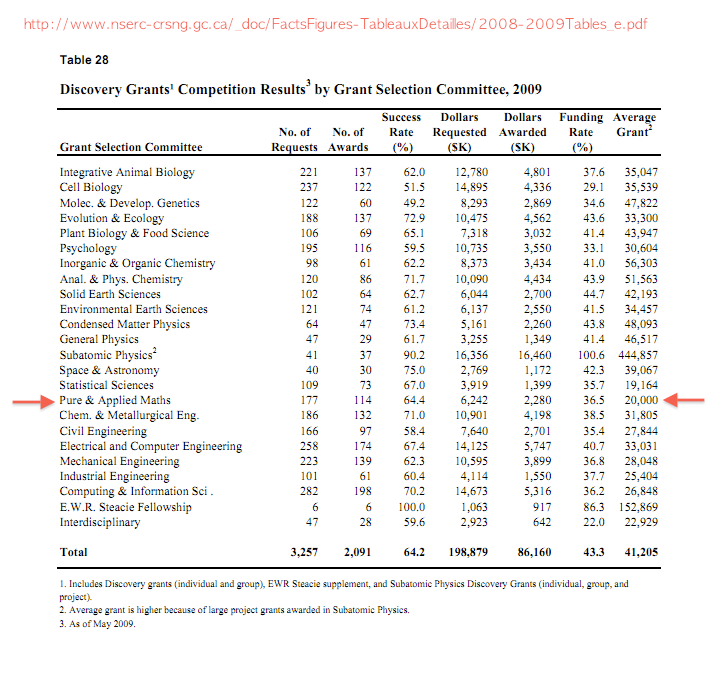Mathematics Discovery Grants are Insufficient and Broken
Beginning this academic year, I have served the Department of Mathematics as the Associate Chair [Research]. The principal responsibility of this position is to administer the hiring process, for tenure stream and postdoctoral appointments. I also recently served on the Connaught Physical Science Review Panel which reviews applications for Connaught funds and adjudicates the McLean Award. Serving on the Connaught Panel has given me a perspective on the research climate in fields outside of mathematics. Metaphorically, these responsibilities have required me to look up from my research papers and out the window at the infrastructure supporting researchers at UofT. I am troubled by what I have seen:
Here is a table generated by NSERC showing the Discovery Grants (DG) data across disciplines. 
Discovery Grants are Insufficient
On average, Canadian mathematicians receive about $20K/y to sustain their research program. This post by Izabella Laba explains how mathematicians typically use this money at UBC. As part of the planning exercise, I suggest we consider how much money a mathematician needs to run a research program. Simple considerations show that $20k is insufficient.- At Toronto, faculty are encouraged to contribute one quarter of their NSERC DG to support graduate students. This amounts to $6K from a typical $20K NSERC DG.
- Faculty pay some incidental expenses related to computing infrastructure costs, printing, etc. Let's suppose these total about $1K.
- Collaborative mathematical research requires travel to bring the coworkers together. A typical research visit requires an airfare purchase and a hotel room. Each research visit costs between \$1K and \$2K.
- The development of graduate students and postdocs into researchers often requires conference participation. The associated travel costs are frequently paid using the advisor's Discovery Grant. Local expenses for sponsored graduate students are often paid by the conference. Each field trip by a graduate student or postdoc costs about $500, sometimes more if the conference is outside of North America.
So, a minimally active researcher with a typical research grant of $20K spends $6K supporting a graduate student, $1K on incidentals, and $4K on research visits leaving $9K.
- At Toronto, postdoctoral positions require between \$32K and \$40K from faculty research grants. This money is supplemented with a teaching stipend to complete the salary package for the postdoc.
Mid-Career Funding Gap
Early research awards (ERA, Sloan, etc.) fund research activities by new faculty. These opportunities are restricted by a time horizon typically around 10 years after the PhD. Young faculty at Toronto with these grants can often solely fund the research component of a Postdoc funding package.
Similarly, eminent senior members of our department with large grants can solely fund postdocs.
Midcareer mathematicians typically must make a deal with their colleagues to assemble the funds to to hire a Postdoc.
Canada’s Discovery Grants funding policies do not adequately support research activity by mathematicians and especially hurts researchers in the middle of their career. Young researchers who win early research awards in Canada are capable of starting a research program. The present funding structure does not allow these emerging mathematicians to fully develop through the mid-Career phase into world class research leaders. Canada has been very effective at recruiting talented young mathematicians during the past decade. When young research stars in Canada start to realize the mid-Career funding gap prevents them from carrying out their research plans, they will leave and go elsewhere.
HQP training is not necessary for spectacular research success.
Why does NSERC require an HQP (Highly Qualified Personnel) component in research plans? I expect the answer has to do with the general goal that the government policies should encourage the training of a highly skilled population. This is a good goal. However, the HQP requirements for Discovery Grants fail to envision the secondary effects of world leading research on the training of future scientists. Consider, for example, the case of Jean Bourgain. Bourgain had one Ph.D student so his HQP production would be viewed as insufficient to merit a Discovery Grant by NSERC. However, Bourgain's advances have created new fields of mathematics where a generation of mathematicians (e.g. Izabella Laba, Wilhelm Schlag, Gigliola Staffilani, Terry Tao ...) has blossomed. The NSERC definition of HQP fails to envision the effects of ground breaking research in the development of future scientists.Henri Poincaré had five graduate students. John von Neumann only had three students. I wonder if they’d qualify for a Discovery Grant given the highly qualified personnel requirements in the funding formulae? My colleague Victor Ivrii made an historical advance by proving Weyl’s conjecture about the eigenvalues of the Laplacian on a domain. Due to the HQP requirement, Victors’s DG is zero. Similarly, my colleague Michael Goldstein advances the frontier with big results which appear in Annals, Annals (again), Acta, etc. and his efforts are rewarded with a $14K/y NSERC DG. Goldstein’s research excellence has been recognized outside of Ottawa.
In my opinion, the fact that Canada fails to invest in the scholarly activity of its world-class researchers is a disgrace. The Discovery Grants system needs to be fixed.